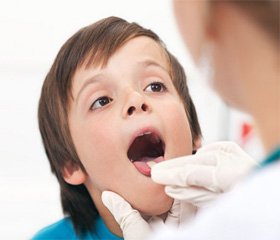Журнал «Здоровье ребенка» 6 (57) 2014
Вернуться к номеру
Nasopharyngeal carriage of Streptococcus pneumoniae in orphanages: the repertoire of serotypes and antimicrobial sensitivity
Авторы: L.I. Chernyshovа, A.M. Gilfanova, A.V. Bondarenko, V.V. - P.L. Shupic National Medical Academy of Postgraduate Education, Kiev, Ukraine; Yanovska, T.G. Glushkevich - Bacteriological laboratory SI "Ukrainian Center of Control and Monitoring of Diseases of the Ministry of Health Care of Ukraine", Kiev
Рубрики: Педиатрия/Неонатология
Разделы: Клинические исследования
Версия для печати
Introduction. S.pneumoniae is a major cause of invasive diseases such as pneumonia, purulent meningitis, bacteremia, and acute otitis media, sinusitis and other diseases of different localization in all age groups worldwide [Dagan, 2009; Farha T, Thomson AH, 2005; CDC, 2010]. The first step in a bacterial disease is the establishment of nasopharyngeal carriage, which also contributes to the spread of pathogens. Young children are considered to be the most important carrier for horizontal dissemination of bacterial strains within the community [Taketo Otsuka, 2013].
Objective. To study of nasopharyngeal carriage S. pneumoniae in orphanages, the distribution of serotypes of pneumococcus and its susceptibility to antimicrobial agents.
Materials and methods. The study involved 68 healthy children aged 6 months to 4 years 11 months 30 days, living in an orphanage Kyiv and Kyiv region. Clinical studies were conducted between October and November 2013. From each child involved in the study were gathered passport information, history, refined data on diseases (acute otitis media, pneumonia, bacterial meningitis, sepsis) and chronic medical conditions or diseases that are associated with an increased risk of pneumococcal infections, the duration the child in an orphanage.
Samples of mucus from the nasopharynx were taken once by deep transnasally smear. For identification of S. pneumoniae used classical bacteriological methods and real-time PCR. Serotyping was performed using the multiplex PCR to serotypes 1, 3, 4, 5, 6A, 6B, 6C, 7F, 9V, 14, 18C, 19A, 19F, 20, 23F. Sensitivity to antimicrobial agents was determined by disc - diffusion method.
Statistical analysis: Parametric test Z; contingency tables and Pearson's χ2 test. The critical value of significance level of 5% was accepted. Obtained during the study data were processed by mathematical statistics using standard software packages Microsoft Excel and IBM SPSS Statistics 20.
Results. Under the observation were 41 boys and 27 girls. The median age was 26 months, with 50% of children age was in the range of 12 to 40 months (Q1 and Q3). There were found 65 carriers of pneumococcus and its frequency nasopharyngeal carriage made up 95.6% (95% CI: 90.7, 100).
Age, sex and length of stay of the child in a closed team did not affect the frequency of carriage of pneumococcus in the nasopharynx, as well as the location of the orphanage. Among the orphanage graduates, 39.7% had an increased risk of pneumococcal infection.
2.4% of children had a history of acute otitis media. Episodes of illness arose before the age of two years are the first two months in the orphanage. Another 16.3% of the children had had a history of community-acquired pneumonia, with 86% of cases were in the first year. It was found that 71% have developed pneumonia in children directly to the orphanage for the first three months. The most vulnerable to the development of pneumococcal disease among children from orphanages are children whose length of stay in the team was less than 3 months, and children at risk.
There have been typing of 62 strains of pneumococcus. Repertoire serotypes of pneumococci was as follows: 19F (54.8%), 6A / B (17.7%), netypovani (12.8%), other seroypy (6.4%), 6A / B 14 (3.2 %), 6A / B +23 F (1.6%), 14 (1.6%), 23F (1.6%). 80.8% nasal carriers were colonized by serotypes responsible for invasive pneumococcal disease development and included in pneumococcal conjugated vaccine (PCV) .
Strains of pneumococci isolated from nasopharyngeal inmates of orphanages, are characterized by high resistance to antimicrobial agents: penicillin (69%), erythromycin (60%), azithromycin (22%), ciprofloxacin (78%), co-trimoxazole (59%). More than half (56%) strains were multidrug pneumococcus. The majority of multi- strains of pneumococcus (83%) belonged to serotype 19F, another 11 % of strains were nontypeable, and only 1 strain (5.5%) - 6 serotypes. Pneumococcus sensitivity to antimicrobial drugs depends on the institution. It was noticed that pneumococcus resistance to certain antimicrobial agent correlated with its serotype.
During the first and second months of observation, respectively 6.8% and 12.5% of carriers of pneumococcus have at least one disease that may be associated with S. pneumonia.
Conclusions. Children who are brought up in orphanages are vulnerable cohort that calls for pneumococcal immunization PCV in the shortest possible time from the moment of receipt to the institution. Children at high risk should be further immunized by 23-valent polysaccharide vaccine.
In the closed type institutions one should carry out routine monitoring of antimicrobial-resistant pathogens with a view to rationalizing antibiotic therapy.

